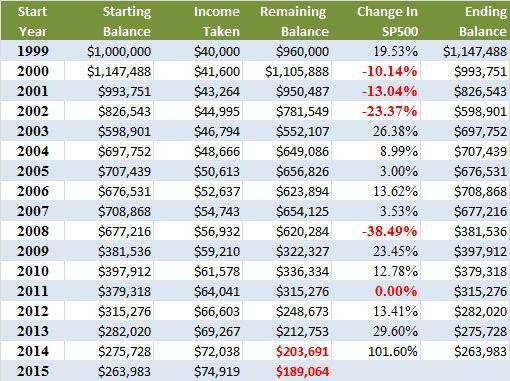How $40k can add $1 million to retirement
Post on: 6 Июнь, 2015 No Comment

You’ve built up your $1 million dollar retirement war chest and you are ready to roll, right? Now imagine you saved an additional $40,000 so that you could push off using your retirement savings for another year.
By living off that $40,000 rather than pulling out the customary 4% from savings in the first year, you could add more than $1 million to your portfolio and I’ll show you how.
In my two most recent columns I described hypothetical retirement income streams for various combinations of asset allocation, how much you have in stocks versus how much in bonds. and withdrawal rates, such as taking out 4% a year versus 5% a year .
The tables in those lessons all assumed that you officially retired at the end of 1969 and started taking withdrawals from your $1 million portfolio at the start of 1970.
Now I want to use many of the same assumptions, with one significant change: Assume that in addition to $1 million you had saved enough additional money to cover your first year of retirement expenses. In the examples that follow, I’ll assume that means you saved an extra $40,000 and that’s how much you will need in your first year of retirement.
Lots of conservative investors like this idea, fearing that the market will go down the first year they start using their savings.
Mathematically, saving this extra $40,000 is similar to waiting one extra year to retire, since you wouldn’t start taking money out of your portfolio in this scenario until January 1971.
When you do this, your portfolio has more money to grow while you are retired. At the end of 43 years of retirement (should you live that long), that extra growth really adds up.
When I saw the numbers in a table that shows this hypothetical model, I was surprised by how much extra portfolio growth a mere $40,000 could produce.
My claim for an extra $1 million makes sense only when the table I just mentioned is compared with another table that excludes the additional $40,000 starting value. For convenience, I will refer to the first one above as the new table and the second as the old table .
Let’s look at some numbers. Consistent with my assumption of a conservative investor, I refer to the 40/60 column in the old table. (In this case, 40/60 stands for a portfolio made up of 40% properly diversified equities and 60% bond funds.) The number at the bottom of that column tells me that after 43 years of distributions taken at the start of every calendar year the portfolio is worth $5,012,712.
To find out what would happen under the extra $40,000 scenario, I look to the bottom of the 40/60 column in the new table. That shows me that the portfolio at the end of 2012 would be worth $6,392,098. That’s a difference of about $1.38 million.
Did that extra $1.4 million make any difference in the lifestyle of this hypothetical conservative investor? Not really, because the annual withdrawals year by year are identical in the scenarios of these two tables. For example, in 1980, each one had the same $81,455 on which to live.
So at this point you could be wondering: What’s the big deal? I think there are four answers to that question.
First, the big deal in this case is an extra $1.4 million that the retiree can leave to family and charities — an enormous increase in a potential legacy.
Second, during retirement, the extra starting value of the portfolio provides an extra cushion or margin of safety, which of course is highly important to our conservative retiree’s peace of mind.
Third, that additional cushion opens up the possibility, which I think might be quite reasonable, of increasing ramping up the equity allocation in the retirement portfolio.
If we look in the new table for the end-of-2012 portfolio value of a 50/50 portfolio, we find it’s $10,626,205 instead of only about $6.4 million. This is an enormous change in what our retiree can leave after 43 years.
If you do the math, that’s turning $40,000 into $4.2 million.
Fourth, there’s something even better. So far, we’ve assumed that the retiree doesn’t take out any of this extra money for living. But after a few years, the additional safety cushion may become large enough to make a higher withdrawal rate comfortable.
Being conservative, let’s assume our retiree stuck with the 4% rate for the first 10 years. At the end of 1979, his portfolio was worth $1,608,174 — well above the initial $1,040,000. If he stuck with the 4% withdrawal rate, he would have $81,455 to spend in 1980.
However, if he switched at that point withdrawing at 5% rate, still adjusted to inflation, he could take out $101,819. That’s a raise of 25%, an extra $20,364 that year to spend.
That one-year raise was more than half the entire extra $40,000. And every year, that raise would be increased. In addition, after 43 years (or whenever his retirement ended) he would have many, many more dollars to leave in a legacy.
To my mind, that’s about the best possible way to use $40,000. It’s worth working a bit longer. It’s worth saving a little more. It’s worth planning for. And it’s worth doing.
Richard Buck and Larry Katz contributed to this report.














